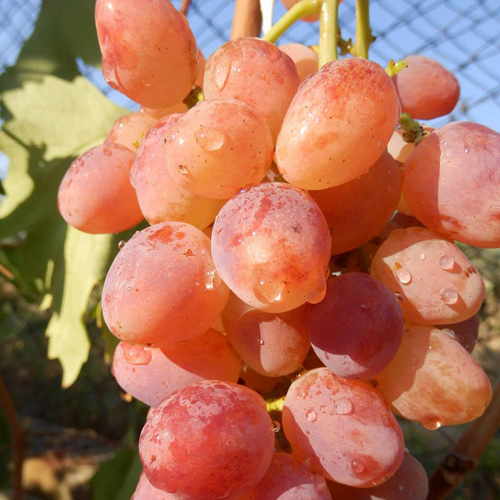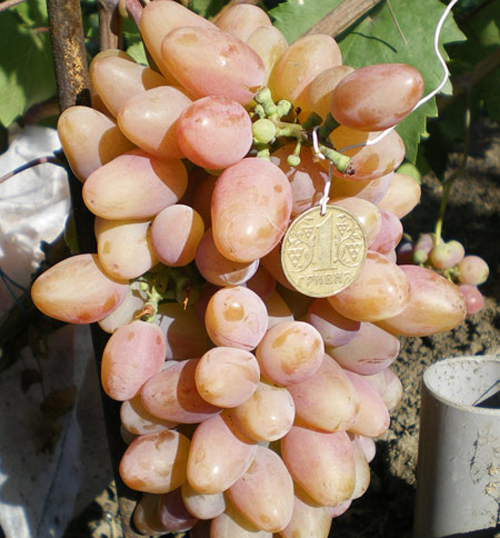Grape variety Nakhodka (Kishmish Nakhodka)
The hybrid form of table grapes Nakhodka is one of the many high-quality varieties of "sunny berries" obtained by one of the leading figures of the national selection of V.N. Krainov. The contribution of Viktor Nikolaevich to the expansion of ampelographic diversity cannot be overestimated at the moment. There is hardly a winegrower in our country who does not know about at least one brainchild of Krainov, and the researcher has brought out several dozen of them during his productive life. Many of these novelties, despite their amateur origin, managed to pass the state test, and, having received the status of a variety, were registered in the Register of Breeding Achievements of the Russian Federation.
However, even those hybrids that did not gain official recognition often won significant success among a large number of winegrowers who cultivate grapes in their backyards, garden and suburban areas. One of them is Nakhodka, the name of which is most often used with the prefix "kishmish". This epithet is not accidental at all - the berries of our hero really contain only rudiments from seeds, referring to the IV class of seedlessness.

It happened as a result of crossing two very famous varieties - domestic Mascot, born in the bowels of the Novocherkassk Scientific Research Institute of Viticulture and Winemaking named after. ME AND. Potapenko, and Moldavian Kishmish Radiant from NPO "Vierul". I must say that this was the author's favorite combination, from which almost half of his masterpieces came from. Our hero from this parental couple inherited many positive qualities, ranging from large-fruited, good taste of berries and attractive appearance, ending with the comparative unpretentiousness of the bushes and their increased resistance to fungal diseases. Of its serious shortcomings, only the functionally female type of flower can be noted, which requires the owner to take the necessary measures to ensure sufficient pollination of plants.
Despite this flaw, Nakhodka raisins have gained a wide circle of their admirers, and the quality characteristics of the variety are eloquently evidenced by the fact that amateur breeders are already beginning to use it as a mother form for breeding hybrids of a new generation.
Agrobiological properties
The growth vigor of the bushes is average or above average. The leaves are large, rounded, consisting of three or five lobes, between which there is significant dissection. The profile of the leaf blade is flat or slightly funnel-shaped due to the lobes raised upward. Its surface is smooth, dark green with light veins that acquire a reddish tint at the base. The upper lateral notches are rather deep, predominantly open, lyre-shaped or parallel-sided, with a rounded bottom. The lower notches are much shallower, they are also open, often V-shaped, but there are also barely outlined ones. The petiolate notch can be vaulted or in the shape of a lyre with a pointed bottom. Petioles are long with bright, well-visible anthocyanin pigmentation. The denticles at the edges of the leaf are fairly aligned, moderately large, triangular and saw-shaped with smooth edges and sharp tops. The flower is functionally female, which is why normal pollination is possible only if bisexual varieties blooming at the same time are planted nearby. To guarantee, manual pollination can also be carried out, otherwise there is a great chance of getting overly loosened bunches as a result of massive shedding of unfertilized flowers. Strong peas are not observed, however, the berries, under unfavorable weather conditions during the flowering period, grow in different sizes, which somewhat spoils the external attractiveness of the brushes. The growth of the current year is ripening on time and for a considerable length. The ripe vine becomes reddish brown.

The bunches grow very large in size, their weight, depending on the completeness of the pollination of the inflorescences, can vary widely - from 700 to 1500 grams. Their shape is conical or branched, the structure is loose or moderately dense. The comb is long, herbaceous, light green in color with pink patches. Berries of standard size are massive, oval-ovate or nipple-shaped, 25 - 27 mm long and 21 - 23 mm in diameter. Average weight 7 - 8 grams. Due to the free arrangement on long legs, the grapes do not wrinkle or deform against each other. On the outside, they are painted in an attractive golden pink color, and the surface is covered with a light layer of protective pruin. The pulp of the fruit is quite dense, pleasant to the taste, harmonious, but without bright shades in the aroma and aftertaste. The juice squeezed out of berries is colorless, its sugar content reaches very high values - 19 - 22 g / 100 cm3, the titratable acidity varies from 4 to 7 g / dm3... The grape skin is medium in thickness and strength; there are no problems with chewing and eating it. There are no full-fledged seeds in the fruits, instead of them there are rudiments, the size of which is not the same from season to season. Due to this, as well as due to other positive characteristics, the tasting properties of Nakhodka raisins are assessed as high.
The harvested grapes are mainly used for fresh consumption. Due to its high marketability and visual appeal, it is in good demand among buyers, and therefore the growers cultivating the variety for sale invariably classify it as a “market” variety. An additional and important advantage for them is the early ripening of the crop, which allows them to start selling it during a period of limited supply and high prices, which ensures good profitability of cultivation. In addition, the bunches of Nakhodka are distinguished by good transportability, which makes it possible to move them over long distances without the risk of the berries falling off the ridge, or getting them otherwise damaged.

Individual farms, growing "sun berries" for their own needs, practice the processing of surplus crops for juices, compotes, preserves and marinades. Our hero shows himself on the good side in this respect, conveying excellent taste and a rich set of vitamins and microelements to home preservation. In winter, when there is a shortage of these biologically active substances in the human body, summer preparations will come in handy.
The duration of the growing season of grapes The find is rather short. From the time the buds open on the shoots in spring until the bunches are ready for harvesting, it takes about 110 - 115 days, and therefore this variety is classified as early maturing. This is confirmed by the modest sum of active temperatures required for plants to reach the harvest of removable ripeness - 2300 - 2400 ° C. Such indicators testify to the possibility of our raisins to grow not only in traditional wine-growing regions, but also much to the north of them, which, by the way, is used by many amateur winegrowers. Here it is worth paying attention to the winter hardiness of the aboveground part of the bushes. Although it is elevated to minus 23 ° C, it nevertheless does not allow cultivating the variety in an open culture in frost-prone regions. Here, plants should be formed according to squat, stumpless schemes, in order to be able to remove the vine from the trellis annually and insulate it for the winter.
The yield of our hero, as a rule, is high, due to the large size of the brushes and the high rate of fruiting. At the same time, a negative feature is the tendency of the bushes to overload, because of which the winegrower must carefully carry out rationing by shoots and harvest.In spring, plants are loaded with 30 - 40 eyes, cutting off the fruit arrows medium (6 - 8 buds) or short (3 - 5). Be sure to carry out a fragment of sterile vines after the beginning of the growing season, and no more than one inflorescence is left on each fruitful shoot. In areas with a long frost-free period, the second, albeit rather modest, harvest, ripening on the stepchildren of the shoots of the current year, can serve as a pleasant bonus.
The resistance of the Find to fungal diseases is average, and therefore for full protection it will take 2 - 3 preventive spraying with fungicides per season.








